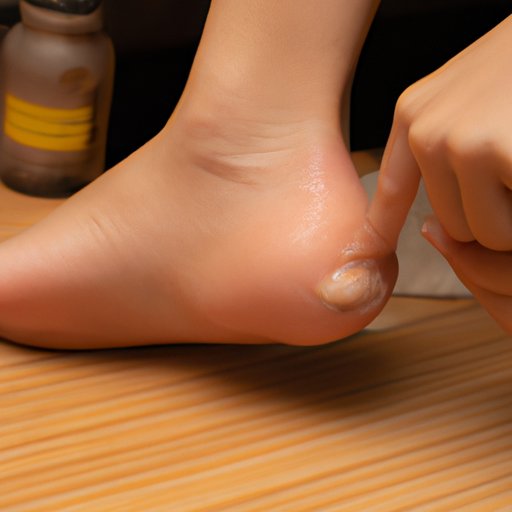Why Do I Keep Getting Cramps in My Feet?
Foot cramps can be an uncomfortable and sometimes painful experience that can range from a mild nuisance to a severe physical disruption. Whether it’s in the middle of the night or during a workout, foot cramps can be a frustrating occurrence that disrupts our daily routines. It’s important to understand the causes of these cramps and the proper measures we can take to prevent and treat them.
Investigating the Causes
There are several causes for foot cramps, from dehydration and nutrient deficiencies to overuse and repetitive stress. Here are some possible reasons:
Dehydration
Dehydration is a common culprit for causing foot cramps. Our muscles need fluids to function well, and when we don’t consume enough, our muscles may contract involuntarily, leading to cramping. This can be a frequent problem for individuals who work out regularly and lose more fluids through sweat.
Nutrient Deficiencies
Deficiencies in certain nutrients like potassium, magnesium, and calcium can trigger foot cramps. Our bodies require these nutrients to maintain healthy muscle function. For example, low levels of magnesium may lead to muscle spasms and cramping, while low calcium levels may lead to muscle weakness.
Overuse
Repeated stress or strain on the feet can lead to muscle cramps. This can happen when we wear improper shoes, have poor posture, or engage in high-impact activities without proper conditioning. Overuse can also cause fatigue in the muscles, leading to cramping.
Prevention Techniques
Fortunately, there are several techniques we can use to prevent foot cramps from happening.
Stretching exercises
Stretching exercises can help to loosen up our muscles, making them less prone to cramping. Experts recommend regular stretching routines, especially before and after physical activity, to prevent cramping and other foot issues.
Proper hydration
Maintaining proper hydration can keep our muscles healthy and flexible. Drinking enough fluids throughout the day, especially during exercise, can keep the muscles hydrated and prevent symptoms like cramping.
Wearing comfortable shoes with good arch support
Wearing comfortable shoes that support our arches and are appropriate for the activity can help prevent foot cramps. Ill-fitting shoes can cause undue stress on the feet and lead to cramping, so choosing the right kind of footwear is essential.
Exercise Habits
If you engage in regular physical activity, you may be more prone to foot cramps. Here are some tips to avoid them:
Modify High-Impact Exercises
High-impact activities like jogging and running can cause foot cramps for some individuals. If you experience foot cramps while running, modifying the intensity or switching to lower-impact exercises like swimming or cycling may be helpful.
Warm-Up and Cool Down
Warming up before exercising and stretching after can help prepare the muscles and prevent cramping. Warm-up exercises can include light jogging or jumping jacks, while cool-down exercises can include gentle stretches.
Home Remedies
If you’re in the midst of a foot cramp, there are several home remedies you can use to alleviate or prevent the pain.
Heating Pads, Ice Packs, and Massage Techniques
Applying heat or cold packs to the affected area or massaging the muscle can help relax the muscles and alleviate cramps. Some individuals find relief by soaking their feet in warm water with Epsom salt, which contains magnesium to promote muscle relaxation.
Medications and Supplements
Over-the-counter pain relievers, muscle relaxers, and topical creams can help alleviate any discomfort. Additionally, taking supplements to address any dietary deficiencies, such as magnesium supplements, can also reduce the occurrence of cramps.
Treatment Options
If home remedies and prevention techniques don’t work, other treatment options are available.
Over-the-Counter Medications and Topical Applications
If the pain persists, you can consider taking over-the-counter pain relievers or using topical creams to alleviate the discomfort. These treatments can offer temporary relief, but it is crucial to follow the package instructions and not to rely on them for long-term relief.
Physical Therapy
Physical therapy can help individuals with chronic cramping issues. Stretching, strengthening, and range-of-motion exercises can help prevent cramps and improve muscle function, and physical therapists can also assess and address any underlying mechanical issues that may be causing the cramps.
Acupuncture
Acupuncture can also help address cramps. Acupuncturists typically work on points throughout the body that are believed to relieve muscle tension and provide pain relief. It can be a good option for those looking for a non-invasive but still effective treatment.
Long-term Solutions
For long-term relief, making some lifestyle changes might be necessary.
Lifestyle Changes
Changing your diet to include foods rich in potassium and magnesium, especially if you have a nutrient deficiency, can help reduce the frequency of cramps. For individuals who rely on medications or supplements, adjusting these can be a long-term solution. Improving your workout routine and wearing the right shoes can also support long-term relief.
Surgical Interventions
Though surgery is seldom necessary, more significant foot issues, such as bone spurs or flat feet, may require surgery for complete relief. Individuals with foot issues that lead to regular cramping should see their doctor or podiatrist for an assessment and proper guidance regarding surgical interventions.
Conclusion
Foot cramps are a common issue that can be caused by several factors, from dehydration and nutrient deficiencies to overuse and repetitive strain. Fortunately, several prevention techniques, home remedies, and treatment options are available to help alleviate and prevent foot cramps. Regular stretching, proper hydration, and wearing comfortable shoes can go a long way in preventing foot cramps, while acupuncture, physical therapy, and surgical interventions can provide relief for more severe cases. Remember that seeking proper medical attention is essential for any chronic foot pain or discomfort.
